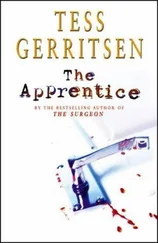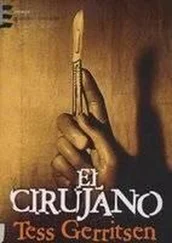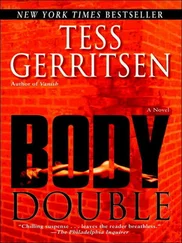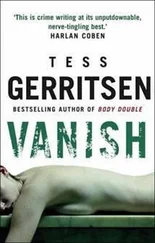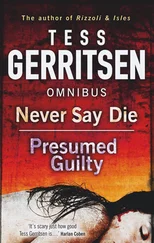The next step had to be performed swiftly. The patient was unconscious now, unable to breathe on her own. Tilting her head back, Zwick slipped a curved laryngoscope blade into her throat, located the vocal cords, and inserted the plastic endotracheal tube. An air-inflated cuff would keep the tube in place in her trachea. Zwick connected the tube to the ventilator and her chest began to rise and fall with the whoosh of the bellows. The intubation had taken less than thirty seconds.
The operating lights were turned on and directed at the table. Bathed in that brilliant glow, Nina seemed unearthly. Spectral. A nurse pulled off the sheet draping Nina's body and exposed the torso, the ribs archirig beneath pale skin, the breasts small, almost shrunken. The resident proceeded to disinfect the operative site, painting broad strokes of iodine across the skin.
The OR doors banged open as Mark, Archer, and Abby, freshly scrubbed, walked in with hands held up, elbows dripping water. They were greeted with sterile towels, gowns, and gloves. By the time everyone was fully garbed, Nina Voss had been prepped and draped.
Archer moved to the operating table. "Is it here yet?" he asked. "Still waiting for it," said a nurse.
"It's only a twenty-minute drive from Logan."
"Maybe they got caught in a traffic jam."
"At two in the morning?"
"Jesus," said Mark. "That's all we need now. An accident." Archer peered up at the monitors. "Happened at Mayo. Had a kidney flown in all the way from Texas. Right out of the airport, ambulance hits a truck. Organ gets squashed. Perfectly matched one, too."
"You're kidding," said Zwick.
"Hey, would I kid about a kidney?"
The fifth-year resident glanced up at the wall clock. "We're going on three hours since harvest."
"Wait. Just wait," said Archer.
The phone rang. Everyone's head swivelled to watch as the nurse answered it. Seconds later she hung up and announced: "It's downstairs. The courier's on his way up from the ER."
"OK," snapped Archer. "Let's cut."
From where Abby stood, she caught only a slanted glimpse of the procedure, and even then her view was intermittent, cut off by Mark's shoulder. Archer and Mark were working swiftly and in concert, making a midline sternotomy incision, exposing fascia, then bone.
The wall intercom buzzed. "Dr. Mapes from the harvest team is here with a special delivery," came the message from the OR front desk.
"We're cannulating," said Mark. "Have him join the fun."
Abby glanced towards the OR door. Through the viewing window, she could see the scrub area beyond, where a man stood waiting. Beside him, on a gurney, was a small Igloo cooler. The same sort of cooler in which she'd transported KarenTerrio's heart. "He'll be in," said the desk nurse. "As soon as he changes clothes." Moments later, Dr. Mapes entered, now wearing greens. He was a small man with an almost Neanderthalic brow and a nose that jutted out like a hawk's beak under the surgical mask. "Welcome to Boston," said Archer, glancing up at the visitor. "I'm Bill Archer. This is Mark Hodell."
"Leonard Mapes. I scrubbed with Dr. Nicholls at Wilcox."
"Good flight, Len?"
"Could've used a beverage service."
Archer cracked a smile, visible even through his mask. "So what'd you bring us for Christmas, Len?"
"Nice one. I think you'll be pleased."
"Let me finish cannulating and I'll take a look."
Cannulation of the ascending aorta was the first step to connecting the patient to the bypass machine.That squat box, under control of the perfusion technician, would temporarily assume the job of the heart and lungs, collecting venous blood, replenishing its oxygen, and pumping it back into the patient's aorta.
Archer, using silk sutures, sewed two concentric 'purse strings' in the wall of the ascending aorta. With a scalpel tip he made a tiny stab in the vessel. Bright blood spurted out. Swiftly he inserted the arterial cannula into the incision and tightened the 'purse strings'. The bleeding slowed to an ooze, then stopped as he sewed the cannula tip in place. The other end of the cannula was connected to the bypass machine's arterial line.
Mark, with Abby retracting, was already starting on the venous cannulation.
"OK," said Archer, moving from the table. "Let's unwrap our present."
A nurse unpacked the Igloo cooler and lifted out the organ, wrapped in two ordinary plastic bags. She untwisted the ties and slid the naked organ into a basin of sterile saline.
GentlyArcher lifted the chilled heart from its bath. "Nice excision job," he noted. "You guys did good work."
"Thanks," said Mapes.
Archer ran his gloved finger over the surface. "Arteries soft and smooth. Clean as a whistle."
"Seems a bit on the small side, doesn't it?" said Abby, glancing across the table. "How big was the donor?"
"Forty-four kilogrammes," said Dr. Mapes.
Abby frowned. "Adult?"
"An adolescent, previously healthy. A boy."
Abby caught the flicker of distress in Archer's eyes. She remembered then that he had two teenage sons. Gently he lay the organ back in its bath of chilled saline.
"We won't let this one go to waste," he said. And he turned his attention back to Nina.
By then, Mark and Abby were already finishing up the venous cannulation. Two Tygon tubes fitted with metal baskets at the end were inserted through stab wounds in the right atria, and secured by purse-string sutures. Venous blood would be collected by these cannula and directed to the pump-oxygenator.
Working together now, Archer and Mark snared shut the inferior and superior vena cava, cutting off return blood to the heart.
"Cross-clamping aorta," announced Mark as he closed off the ascending aorta.
The heart, cut off from both venous inflow and arterial outflow, was now a useless sac. Nina Voss's circulation was under the complete control of the perfusionist and her magical machine. Also under her control was the body temperature. By chilling the fluids, the body could be slowly cooled down to twenty-five degrees centigrade — profound hypothermia. This would preserve the newly implanted myocardial cells and lessen the body's oxygen consumption.
Zwick turned off the ventilator. The rhythmic wheeze of the bellows ceased. There was no need to pump air into the lungs when the bypass machine was doing the work. Transplantation could now proceed.
Archer cut the aorta and pulmonary arteries. Blood gushed out into the chest, spilled onto the floor. At once a nurse threw a towel down to soak up the mess. Archer kept working, oblivious to the sweat beading his forehead, to the lights burning down. Next he transected the atria. More blood, darker, splashed Archer's gown. He reached elbow deep into the chest cavity. NinaVoss's sick heart, pale and flabby, was now lifted away and dropped into a basin. What remained was a gaping hollow.
Abby glanced up at the monitor screen and felt an automatic rush of alarm at the flat EKG line. Of course there was no tracing. There was no heart. In fact, all the classic signs of life had ceased. The lungs were still. The heart was gone. Yet the patient still lived.
Mark lifted the donor heart from the basin and lowered it into the chest. "Some folks call this procedure a glorified plumbing job," he said, rotating the heart to match up the left atrial chambers.
"They think it's like stitching together a stuffed animal or something. But you let your attention slip for a minute, and before you realize it, you're sewing the heart in backwards." The fifth-year resident laughed. "Not funny. It's happened."
"Saline," said Archer, and a nurse poured a basin of chilled saline over the heart to keep it cold under the lights.
"A hundred things can go wrong," said Mark, his suture needle taking deep, almost savage bites into the left atrium. "Drug reaction. Anaesthetic disasters. And damn it, the surgeon always gets the blame."
Читать дальше





